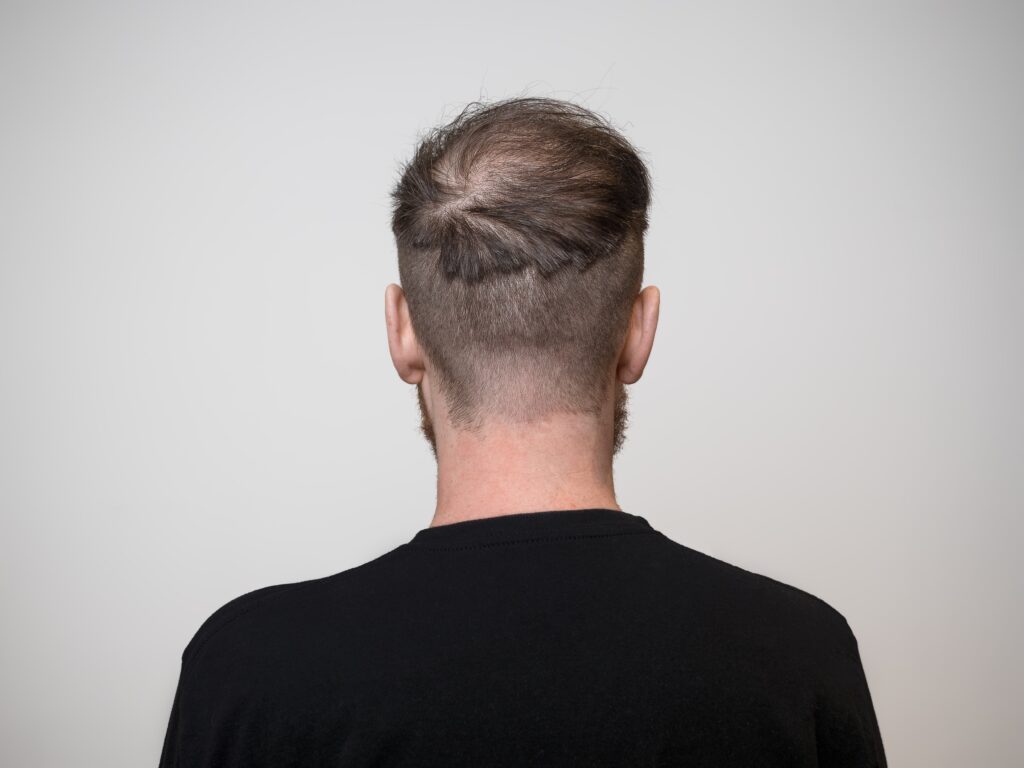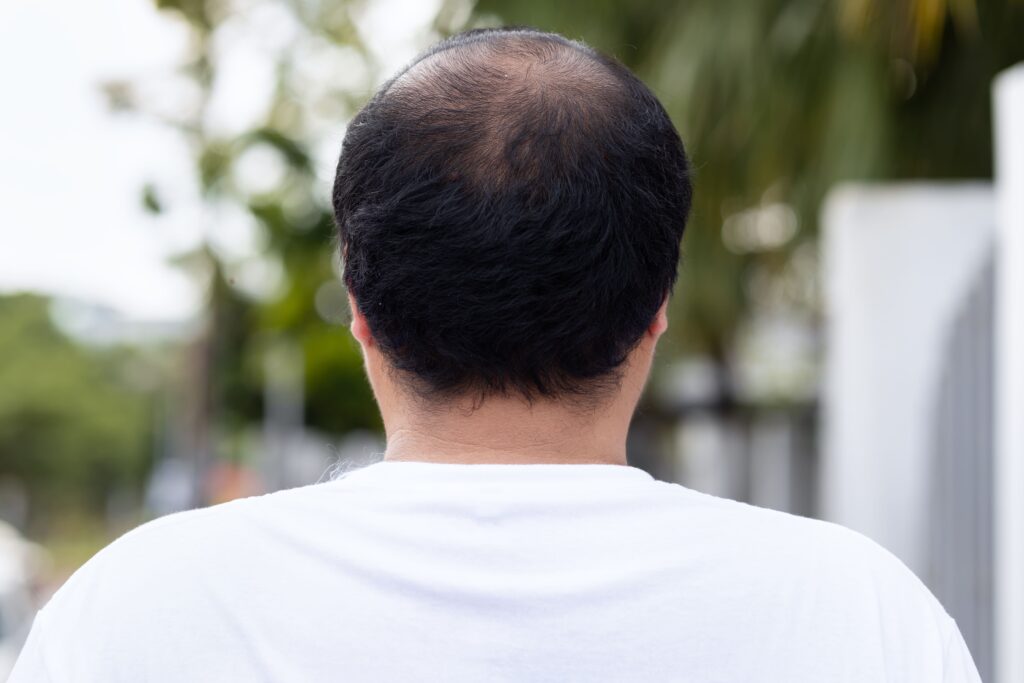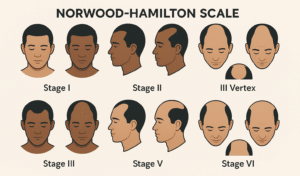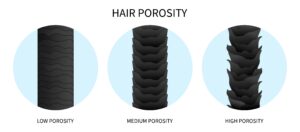Knowing about the Norwood scale is one thing that should concern all men, as every man will experience male pattern hair loss at some point in their life. Statistics have shown that more than half of all men experience significant hair loss by 50.
Although hair loss affects most men, the degree of hair loss varies from person to person. So, the Norwood scale was invented to adequately measure and classify male pattern hair loss into stages to determine the correct hair restoration treatment.
What is the Norwood Scale?

The Norwood scale is used to classify and diagnose the stages of male pattern baldness or androgenetic alopecia (the most common pattern of hair loss in men). Hair surgeons worldwide use this scale to diagnose the condition. The scale is easy to understand, and it adequately covers every stage of hair loss in men.
The Norwood scale is also called the Hamilton-Norwood scale. James Hamilton introduced the measurement scale in the 1950s.
In 1975, Dr O’Tar Norwood revised Hamilton’s classification after studying hair loss conditions in 1,000 patients. This study helped him develop a chart that could describe every stage of male pattern hair loss. The scale was first proposed for general use in 1975.
Today, hair restoration surgeons use the Hamilton-Norwood scale to determine the adequate number of grafts required for hair transplant surgery. The Norwood scale classifies male hair loss into 7 stages, each with its distinct hair loss zone and severity.
Norwood Stage 1-7

Stage 1
The first stage of the Norwood scale describes the typical adult male hairline with little or no balding. At this stage, there’s no visible hair loss around the crown or any other part of the head.
At most, the individual may notice slight shedding around the temples. This stage doesn’t require any treatments. At most, the individual gets a few tips or products to reduce shedding.
Stage 2
Patients at this stage may have thinning hairs on either side of the head, and a hair transplant may not be necessary. Simple hair treatment products may suffice for this stage.
Stage 3
At this stage, the hairline recedes more dramatically, forming an M-shape at the temples. In some men, hair loss occurs at the crown of their heads (the vertex). In stage 3 vertex, men typically exhibit this pattern of hair loss.
Stage 3 marks the onset of balding, prompting a recommendation for hair transplant surgery at this stage. A hair surgery for stage 3 will require about 500 to 2,500 grafts, while stage 3 vertex will require 3,000 hair grafts.
Stage 4
Stage 4 hair loss is a more pronounced version of stage 3. At this stage of hair loss, men lose a substantial amount of hair at the temples and the crown.
Some men may only experience hairline recession at this stage, while their crown hair remains intact. For this stage, hair transplant surgery is recommended. It would typically require at least 3000 grafts.
Stage 5
Severe hair loss at the crown and temples characterizes this stage. The hair separating the 2 balding areas (top of the head and hairline) also becomes thinner.
Some men experience no hair loss from the crown, but the hairline recession surpasses that of stage 4. A hair transplant for this stage will require 4,000 grafts at least.
Stage 6
At this stage of hair loss, extreme balding occurs, and the band of hair separating the balding crown and the receding hairline almost disappears.
If there’s no balding at the top of the head, the patient’s hairline now recedes almost to the back of the head. At this stage, a hair transplant is inevitable and will require 5,000 grafts of hair or more.
Stage 7
This is the final and most advanced stage of hair loss, as described by the Norwood scale. At this stage, you have a band of hair around the back and sides of the head. Other parts of the head are already completely bald.
Patients at this stage may be too late for a hair transplant, though there have been a few cases of successful completely bald hair restoration surgeries.
Such treatment, however, will require a true professional so the remaining healthy hairs won’t get damaged or over-extracted. If sufficient body hair is present, one can also opt to have chest or beard hair transplanted to the head.
Can you go from Norwood Scale 2 to 1?
Usually, hair loss progresses from one stage to the other. However, if the hair loss was caused by other factors like lifestyle, habits, or stress, a positive change may reverse the effects, thereby restoring the receding hairline in stage 2 back to stage 1. Also, hair treatment products may help improve hair growth.
At what age do men start balding?

There’s no specific age for balding in men. It all comes down to genetics. For some men, it can be as early as their 20s or teenhood; for others, it may be in their 60s.
Typically, men lose hair as they get older. However, statistics show that 60% of men experience significant hair loss by 35 to 40 years, as this is when Dihydrotestosterone levels begin to decrease. And by age 50, 85% of men are already balding.
Do all men reach Norwood Scale 7?
No. The extent of your hair loss depends on your genetics and your DHT (Dihydrotestosterone) levels. Some men are extremely prone to getting bald and will reach level 7 despite hair loss treatments. Some other men will never reach level 7, even without hair treatment.
Normally, your hair loss pattern will start manifesting in your 30s. So, if you will have a Norwood 7, it will become evident by age 40. However, men are advised to undergo hair transplant surgery during the earlier stages of hair loss (Norwood stages 2-5) to prevent irreversible hair loss.
Why do some men not go bald?
Here are some of the reasons why some men do not get bald:
- Genes: Genetics are the major factors that determine when a man’s baldness begins.
- Low DHT levels: Too much DHT is extremely detrimental to the health of hair follicles.
- Healthy lifestyle: No smoking, drinking or other addictions.
- Good food that promotes the growth of healthy hairs
- Stress-free lifestyle: Stress can cause hair thinning or hair loss in both men and women.
At what stage is a hair transplant not possible?

Hair transplants can be done at any stage. However, stage 7 patients are usually advised against getting a hair transplant, as there is usually just not enough donor hair to achieve satisfactory coverage.
However, there have been cases of successful hair restoration surgeries for Norwood stage 7 patients, mostly with the help of body hair. Therefore, a hair transplant in Turkey is possible at any stage; you just need to locate skilled hands and have sufficient body hair growth.
Frequently Asked Questions
In some cases, lifestyle changes or treatments may halt or reverse hair loss, potentially regressing from Norwood stage 2 to 1. However, results vary depending on individual factors.
No, the progression to Norwood stage 7 varies based on genetics and DHT levels. Some may reach this advanced stage despite treatment, while others may not experience it at all.




